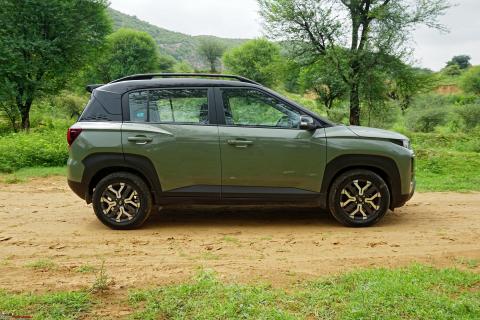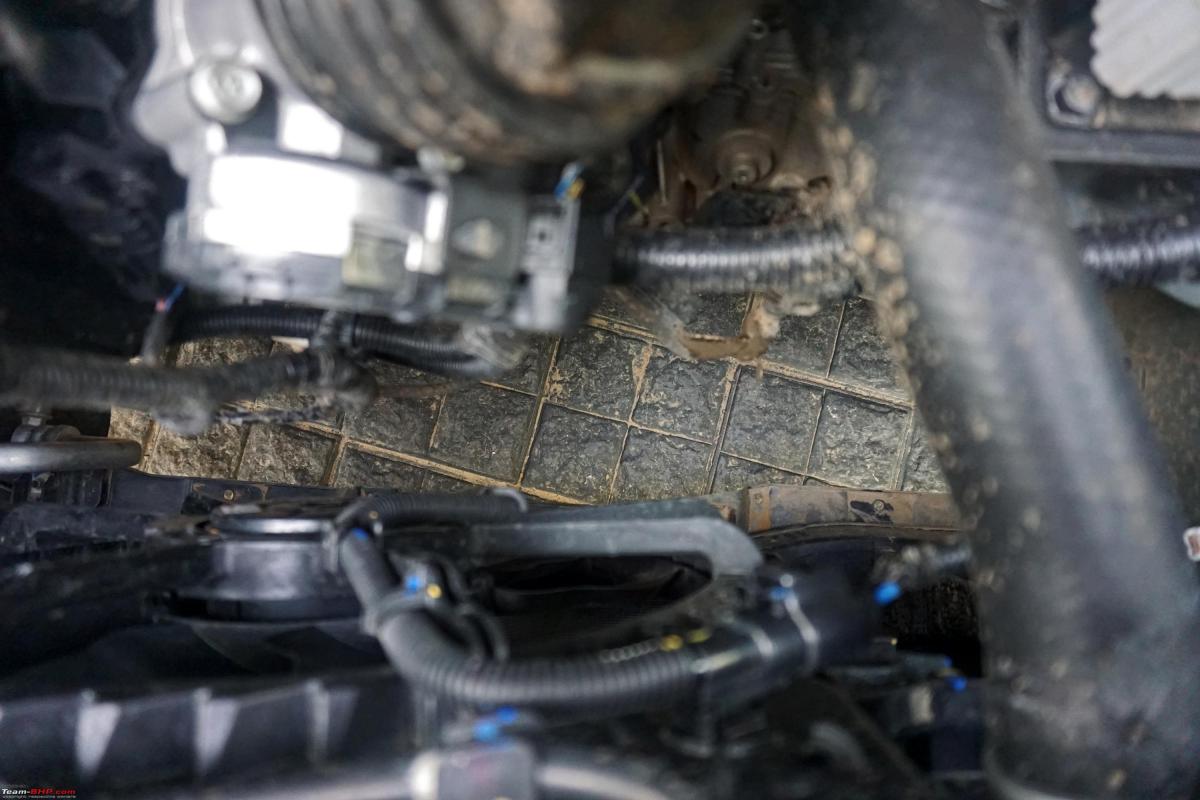The Exter has a suspension setup that’s on the softer side. Straight-line stability is good for a car in this segment and occupants won’t even know that the car is cruising at triple-digit speeds.
Driving the Hyundai Exter 1.2L Petrol MT
1.2L petrol engine makes 82 BHP @ 6,000 rpm and 114 Nm @ 4,000 rpm:
The Exter is powered by the same 1.2L, 4-cylinder NA petrol that does duty in the Grand i10 Nios, Aura and Venue. It puts out 82 BHP, which is more than the NA units of the Citroen C3, Nissan Magnite and Renault Kiger, but lower than the Maruti Fronx’s 89 BHP and Tata Punch’s 87 BHP.
The petrol engine has been around for a while now, but it is still a gem of an engine. With your foot on the clutch, press the engine start/stop button. One can immediately notice the sheer refinement of this motor. The petrol starts seamlessly. Torque delivery at low rpms and in city driving conditions is satisfactory by petrol standards. We could pull the engine from 800 rpm without any effort. Use the clutch and the engine will pull from as low as 500 rpm! Closing the gap to the car in front is no problem. One can drive around at 40 km/h in 5th gear with the tachometer reading 1,100 rpm. The refinement levels are outstanding and power comes in smooth. I didn’t observe a single flat spot in the entire rpm range.
Prod the engine further and its rev-happy nature becomes immediately evident. The 1.2L petrol feels eager on the open road and climbs clean to the 6,600 rpm limit. There is plenty of mid-range punch. The engine starts coming into its stride and ~1,700 rpm and pulls strongly from ~2,200 rpm Overtaking fast traffic only requires a downshift. Expressway performance is adequate. In terms of cruiseability, in 5th gear, 100 km/h is seen at 2,800 rpm. Overall, we would describe the performance of the Exter to be adequate, but not exciting.
The 5-speed manual transmission is slick to operate. The throws are smooth and sure-slotting. The clutch is super light and the travel range is average.
Noise, Vibration & Harshness (NVH)
There is a very slight shake of the body as the engine cranks, but other than that, there are no vibrations felt inside the cabin. At idle, you will not even know that the engine is running. While driving around calmly, the cabin remains silent. Even at 80 km/h. one doesn’t need to raise his voice to talk to the other occupants of the car. However, as the revs climb past 3,200 rpm or so, the engine makes itself heard in the cabin. The engine feels smooth when high-revving, though it can get fairly vocal over 5,000 rpm. It never sounds rough or bad.
Wind noise starts creeping into the cabin above 100 km/h. While it gets louder with speed, it’s not excessive at 120 km/h. Road noise and tyre noise are average.
Mileage & Fuel Economy
The 1.2L naturally aspirated petrol has an ARAI-certified fuel efficiency of 19.4 km/l for the MT and 19.2 km/l for the AMT. In our short drive, which included some fast driving we saw 15-16 km/l on the MID. With better driving, we are pretty sure that the engine will deliver much better FE figures.
No insulation sheet under the bonnet:
No underbody protection. You can see the ground below clearly:
Suspension
Ride Comfort
The Exter comes with a McPherson strut suspension at the front and a coupled torsion beam suspension at the rear. The ride over small potholes and uneven roads at city speed is compliant. No bumps are transmitted hard into the cabin. Even over bad roads, the suspension does a good job of keeping the car’s occupants comfortable. Of course, large potholes do register themselves in the cabin, but overall, the ride quality is very compliant. The suspension works silently too.
The higher variants of the Exter ride on 15-inch wheels with 175/65 section tyres and the recommended tyre pressure is 32 PSI.
Handling & Dynamics
The Exter has a suspension setup that’s on the softer side. Straight-line stability is good for a car in this segment and occupants won’t even know that the car is cruising at triple-digit speeds. Expansion joints on the highway do not unsettle it, but there it does wallow a little.
On long curves, the car holds its line well. Push the car on twisty roads and you will experience body roll. Our test car came with 175/65 R15 JK UX Royale tyres. While these are fine for regular driving, they are just not good enough for spirited cornering. The body roll, numb steering and skinny tyres mean that the Exter is not very happy being pushed hard on twisty roads. It’s better to drive the car within its limits and yours.
Steering
The Exter gets an electric power steering, which is very user-friendly. It’s light at parking and city speeds and most owners will appreciate that. The compact dimensions of the car, light steering and a tight turning radius make it very easy to drive in the city. At higher speeds, the steering weighs up and there’s little vagueness in the centre. However, from an enthusiast’s perspective, there’s nothing on offer. It feels very disconnected and light even at high speeds and on twisty roads, you will find that it doesn’t relay much feedback.
Braking
The Exter is equipped with disc brakes at the front and drum brakes at the rear. The performance is as expected and the car comes to a halt without much drama. Under hard braking too, the car doesn’t lose its composure. That being said, wider tyres would have improved braking further.
Continue reading the discussion on the Hyundai Exter on our forum.
Source: Read Full Article




